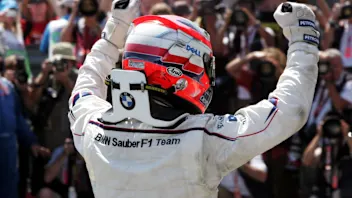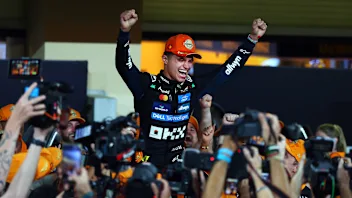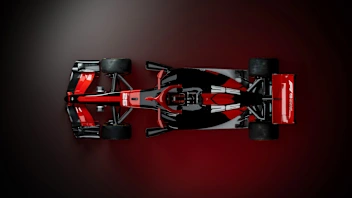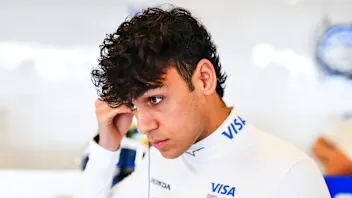From flyaway to factory - what happens when an F1 team gets back to base?
The opening two months of the 2015 FIA Formula One World Championship have seen the teams race in Australia, Malaysia, China and Bahrain - and in all that time the cars haven’t returned to their respective factories in Europe. So what happens when the teams finally get their precious machines back to base? We spoke to Force India’s Race Team Operations Manager, Mark Gray, to find out…
48 days - and four hard fought races - had passed between Force India’s pair of VJM08s leaving the factory in Silverstone for the Australian season-opener and returning back to HQ from Bahrain, so it’s perhaps unsurprising that Gray said his squad’s cars were looking “a little tired” when he unpacked the freight on the Tuesday morning after the race in Sakhir.
A glance at the calendar shows there’s a three-week gap between the Grands Prix in Bahrain and Spain, but with a tight logistical schedule and routine servicing and repairs to be done, there was never going to be a chance for Force India, or any of the other teams, to experience any down time. In fact, preparations for Barcelona began in earnest on the Sunday evening after Sergio Perez’s eighth-place finish.
“I actually had both cars stripped fully in Bahrain on Sunday night whilst we were packing up there,” explains Gray. “So the cars came back in the air freight in kit form - all the parts were stripped - and what that meant was that when the freight came back it was just a case of getting those parts into the relevant departments (in the factory).
“It meant that I could get the chassis off to paint, the bodywork that needed repairing into repair and so on.”
This approach meant that although Gray only collected the team’s freight from the airport on the Tuesday morning after Bahrain, by that afternoon all of the departments in the factory were busy because they had everything they needed to get on with their jobs.
“What that means to me is that they turn those parts around much quicker than if they have to wait for a car to be stripped when it gets back,” explains Gray. “That then leads on to me having the parts back quicker and subsequently being able to build the cars back up again sooner. So it plays into my hands a little bit more - and gives the factory a little bit of breathing space - if I get those bits stripped before we come back.”
Whilst a lot of post-race service work and repairs are carried out in-house, Force India’s deal with Mercedes-Benz means that their engines and associated energy recovery systems are shipped straight back to the German manufacturer’s UK base in Brixworth, whilst the squad’s gearboxes and hydraulic systems - provided by the Mercedes team - return to the world champions’ factory in Brackley.
After unpacking the freight, one of the first jobs that is tackled back on UK soil is getting the pair of chassis repainted to remove the stone chips and scrapes that have accumulated over the first four races.
“We tend to try to get four races out of a chassis paint,” says Gray, “but then probably only two races for all the bodywork - maybe even one depending on where we’re racing.
“(At the flyaways) we send stuff backwards and forwards to the UK (for painting) or take enough quantities of parts so that we can rotate them.
“With some of the bigger teams it’s a little bit different - they build and take enough chassis so they can rotate them as well, but for ourselves we don’t have the luxury of doing that. We just have to keep them going throughout.
“Now, for the first time, we have them available to go to paint, so they’ll look nice again for Spain and Monaco. There’ll be a possible repaint after Monaco because you never quite know what that race is going to bring with all the walls and incidents. Also because Monaco is a street track you tend to pick up more damage and debris from those sort of tracks, so we would tend to do a full repaint after Monaco. In fact generally after every two races in Europe we’d tend to do that.”
Unlike other teams who have painting facilities on site, Force India use an outside company to ensure their paintwork is up to scratch.
“Essentially I tell them when they can come and pick the parts up,” says Gray. “I then prioritise which parts I want back first - for example a chassis is more important than a sidepod. We normally say it’s a two-day turnaround for something like that.”
Once the chassis are back from painting, the team can begin to re-build the cars for Barcelona. The proximity of the circuit to the team’s factory means that for the first time this season the cars can be transported by road rather than air freight, and that in turn means the team can do more work at base and less on arrival.
“For European events, like Spain, we normally go to those races with the engines and gearboxes fitted and the car pretty much fully built,” explains Gray. “Obviously for the flyaway events it’s not possible to do that (because of packing constraints), so they go almost as a bare chassis and we have to build them when we arrive. Likewise, in Europe it’s possible for us to send the car back in one piece as a rolling chassis, possibly even with the engine fitted.”
The beginning of the European leg of the championship is traditionally a time for introducing new development parts to the cars, and as Gray explains, this also has a big impact on the post-Bahrain workflow.
“We have quite a big [upgrade] package coming over the next few events that we need to fit. Sometimes it’s just a case of bolting a new part on, but others include bodywork changes and some quite large changes.
“This is the first time that the teams have the freedom to do some of the bigger items. So there’s a lot of things going on behind the scenes, pre-fitting stuff, trialling stuff and rig testing stuff so that you’re ahead of yourself when the quantity (of parts) come so that you can run them on the car.”
But it’s not just the cars that have to be accounted for in preparation for the resumption of racing on European soil - there’s also the rest of the team’s equipment to consider.
“Most of the car-related equipment - like jacks - are in the air freight, so they all have to be transferred to the trucks for the European events,” says Gray. Relatively trivial items like chairs, wiring and garage panelling also have to be loaded onto the trucks because, as Gray explains, this kind of equipment doesn’t return home during the season.
“We have five sea freight kits that don’t go to any European events - they just go between the flyaway events. They’ve got general equipment in them - stuff like fire extinguishers and other things that you need everywhere but that you wouldn’t want to air freight around the world. For example, Australia’s (kit) is heading to Canada as we speak.”
Given the amount they have to get through between races, it’s perhaps unsurprising that Gray regards the events themselves as the easier side of his job.
“From our point of view the race weekends are very routine,” he says “You do the same thing from one race to another, so it doesn’t matter if you’re in Australia or at Silverstone: the format’s the same, even if the time differences are different with some of the twilight races. From that side it’s fairly easy. For me, it’s these periods between races that are the tricky times...”
Next Up
Related Articles
 Tremayne'Why I’ll always have a soft spot for Sauber'
Tremayne'Why I’ll always have a soft spot for Sauber' UnlockedQUIZ: 10 questions on the new World Champion Lando Norris
UnlockedQUIZ: 10 questions on the new World Champion Lando Norris Everything you need to know about F1's new rules for 2026
Everything you need to know about F1's new rules for 2026 Beyond The GridThe best of 2025, from Norris’ evolution to Brad Pitt’s ‘need for speed’
Beyond The GridThe best of 2025, from Norris’ evolution to Brad Pitt’s ‘need for speed’ Lindblad's car number confirmed for rookie season
Lindblad's car number confirmed for rookie season Marko ‘believed in me when others didn’t’ – Lindblad
Marko ‘believed in me when others didn’t’ – Lindblad